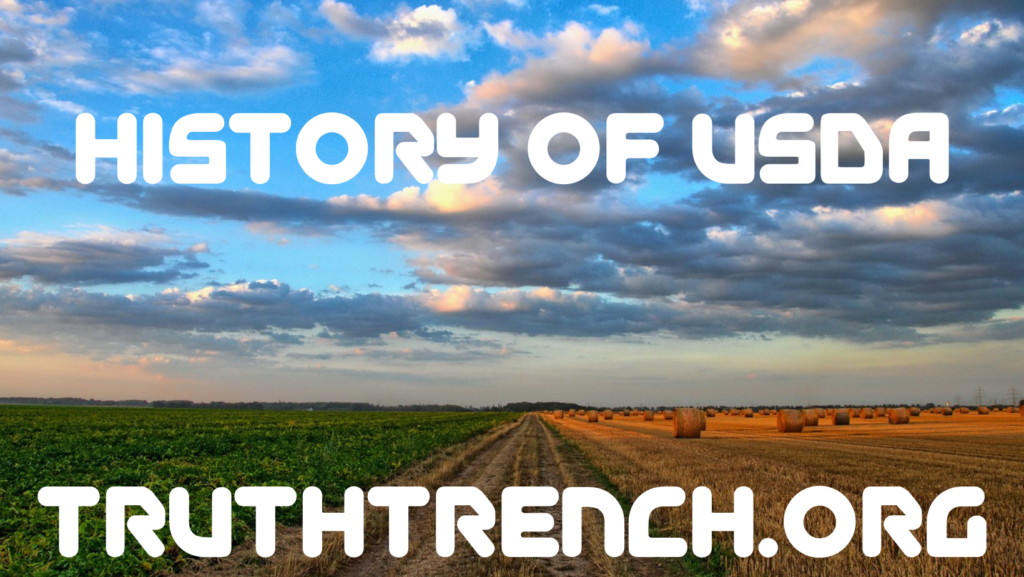In the pursuit of knowledge and truth, patriotic truth seekers often find themselves drawn to the intricacies of government agencies. The Department of Agriculture (USDA) is no exception. Join us on a journey as we delve deep into the USDA, uncovering its history, responsibilities, and impact on American lives.
The Department of Agriculture’s origins date back to 1862 when President Abraham Lincoln signed the Morrill Land-Grant Act. This visionary move laid the foundation for agricultural education and research in the United States, cementing the USDA’s role in promoting agricultural progress.
The USDA’s primary mission is to support American agriculture. Here are some key responsibilities:
Grants for Agricultural Innovation: The USDA understands that innovation is key to the future of farming. Through grants, it empowers farmers to embrace cutting-edge technologies and sustainable practices. These grants fund research into crop resilience, disease management, and eco-friendly farming techniques, equipping farmers with the knowledge and tools needed to adapt to evolving agricultural challenges.
Subsidies for Price Stability: Agricultural markets are susceptible to price fluctuations, which can significantly impact farmers’ livelihoods. To mitigate these risks, the USDA administers subsidy programs aimed at stabilizing commodity prices. These subsidies provide a financial safety net for farmers, ensuring that they can weather market volatility while also guaranteeing that consumers have access to affordable and consistent food products.
Loans for Farming Success: Capital is the lifeblood of any farm operation, whether it’s used to purchase land, machinery, or seeds. The USDA offers a variety of loans tailored to the specific needs of farmers. These loans empower both new and established farmers to expand their operations, increase productivity, and navigate unforeseen challenges. By providing access to crucial funding, these loans foster the continued growth and resilience of American agriculture.
Food Safety: Safeguarding the Nation’s Well-being
Ensuring the safety of our nation’s food supply is a top priority for the USDA. This commitment is essential for protecting consumers and maintaining public trust in our food system. The USDA plays a pivotal role in monitoring and regulating food production and distribution.
Stringent Quality Standards: The USDA enforces rigorous quality standards for meat, poultry, and egg products, which are crucial for preventing contamination and foodborne illnesses. Through continuous inspections and stringent regulations, the department ensures that only safe and wholesome food products reach American dinner tables.
Food Labeling and Traceability: The USDA mandates accurate food labeling, enabling consumers to make informed choices about the products they purchase. Additionally, it implements traceability systems to quickly identify and address potential food safety issues, enhancing responsiveness in times of crisis.
Rural Development: Fostering Prosperous Rural Communities
Rural communities are the heart of our nation, and the USDA is dedicated to their growth and sustainability. The department plays a pivotal role in promoting rural economic development, improving infrastructure, and providing housing initiatives.
Economic Growth: Through grants, loans, and technical assistance, the USDA supports rural businesses, creating jobs and stimulating economic growth. Initiatives such as the Rural Business Development Grant Program help entrepreneurs and small businesses thrive in rural areas.
Infrastructure Enhancement: Robust infrastructure is essential for rural communities to flourish. The USDA invests in vital projects, such as improving roads, bridges, and broadband access, thereby enhancing the quality of life and increasing economic opportunities for rural residents.
Housing Initiatives: Access to safe and affordable housing is a fundamental need in rural areas. The USDA offers programs like the Single-Family Housing Direct Loan Program to help individuals and families secure homes in rural communities, contributing to stable, vibrant neighborhoods.
Nutrition Programs: Alleviating Hunger and Improving Nutrition
The USDA’s commitment to nutrition programs extends nationwide, addressing food insecurity and improving the overall health of our citizens.
SNAP (Supplemental Nutrition Assistance Program): SNAP provides crucial assistance to low-income individuals and families, helping them purchase nutritious food. It not only alleviates hunger but also supports local economies by injecting funds into grocery stores and markets.
School Lunch Programs: Ensuring that our children receive balanced and nourishing meals is a top priority. The USDA administers school lunch programs, setting nutrition standards and providing financial support to schools to offer healthy meals to students, setting them on a path toward better lifelong health.
Conservation Efforts: Preserving Natural Resources and Sustainability
Preserving natural resources and promoting sustainable agriculture are central to the USDA’s mission. The department oversees various conservation programs with these objectives in mind.
Soil and Water Conservation: Conservation programs encourage farmers to adopt practices that enhance soil health and reduce water pollution. These efforts promote long-term sustainability while preserving vital resources for future generations.
Wildlife Habitat Protection: The USDA’s conservation initiatives also extend to protecting wildlife habitats and biodiversity. By promoting conservation practices, the department helps maintain a healthy and balanced ecosystem within agricultural landscapes.
The USDA’s work affects every American, from the food on our plates to the rural communities we cherish. By supporting farmers, ensuring food safety, and advancing agricultural research, the USDA plays a vital role in our nation’s prosperity.
In the quest for truth, understanding government agencies like the Department of Agriculture is paramount. By exploring its history, roles, and impact, we shed light on the crucial work that goes on behind the scenes to uphold our nation’s agricultural heritage. Patriotism and truth-seeking go hand in hand, and the USDA’s contributions to America’s well-being are an essential part of that journey. Some question the effectiveness of the USDA to meet it’s mission, calling it yet another bureaucracy.
Keep tabs on this juggernaut of an agency with Truth Trench – Click here

